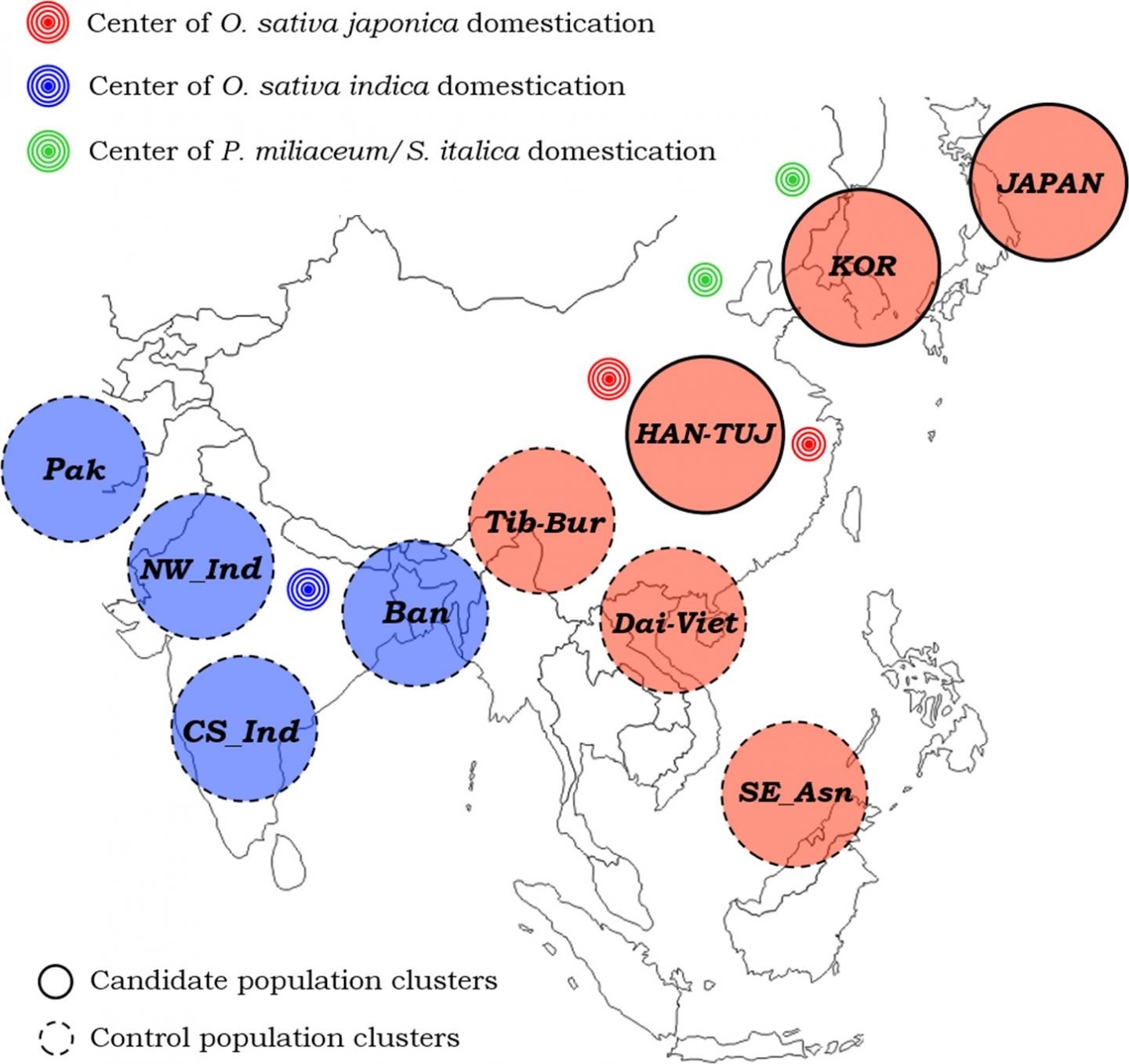Rice-based diet is a traditional food among certain east-Asian population and has ushered in several genomic adaptations that may play a role in mitigating the spread of obesity and diabetes.

Blue clusters showed predominant South Asian ancestry, while red ones are enriched for East and South East Asian ancestry. Red concentric circles indicate archaeological sites along the Yangtze River valley in Eastern China where remains suggesting usual consumption of wild rice have been dated to at least 12,000 years ago. Green concentric circles indicate archaeological sites in the Hebei and Manchuria provinces of Northern China where remains suggesting early cultivation of broomcorn millet and foxtail millet were found. Conversely, all the remaining clusters were used as control groups (i.e., populations not expected to have evolved adaptations to cereal-based diets despite using rice as a staple food). Blue concentric circles indicate archaeological sites across the Indo-Gangetic Plain where evidence for more recent domestication of O. sativa indica was found. Image Credit: Evolutionary Applications.
This fascinating hypothesis was recently proposed by an international study headed by the University of Bologna. The study has been published in the Evolutionary Applications journal.
Scientists have examined and compared the genomes of over 2,000 subjects from a total of 124 south-east-Asian populations.
We suggest that it may be possible that some east-Asian populations, whose ancestors started eating rice on a daily basis at least 10,000 years ago, have evolved genomic adaptations that mitigate the harmful effects of high-glycaemic diets on metabolism.”
Marco Sazzini, Study Coordinator and Professor, Department of Biology, Geology and Environmental Sciences, University of Bologna
Professor Sazzini continued, “Furthermore, these adaptations plausibly continue to play a pivotal role in protecting them from the negative effects that derive from major dietary alterations brought about by the globalisation and westernization of their lifestyles. These alterations dramatically increased their consumption of food rich in processed sugar and with a high glycaemic index.”
Rice and glycemic index
Rice is rich in carbohydrates and has a high glycemic index among the so-called domesticated cereals. This means that as soon as rice is ingested and digested, it increases the blood sugar levels.
If rice is consumed frequently and in large amounts, it may pose a potential risk factor for developing insulin resistance and associated metabolic disorders, like type 2 diabetes.
However, when the researchers made a comparison between the east-Asian populations, who have been using rice as a staple food for more than 10,000 years, and the Indian sub-continent populations, they observed that the latter show higher rates of obesity and diabetes than east-Asians. But what is the reason for this difference in these two groups?
A 10,000-year-old diet
Archaeology may offer a clue to solve that question. Archaeobotanical discoveries in certain eastern areas of Asia demonstrate that wild rice had been a part of the inhabitants’ diets long ago, that is, about 12,000 years ago.
After the domestication of rice and the advent of rice farming methods, from 7,000 to 6,000 years ago, rice spread quickly across Japan and Korea.
In northern areas of the Indian sub-continent, a separate domestication procedure had begun 4,000 years ago and introduced the selection of rice varieties that presented a lower glycemic index when compared to the rice varieties in east-Asia.
Different rice varieties and a head start of millennia may have put populations in China, Korea, and Japan under a more pressing metabolic stress than that experienced by south Asian populations. This might have allowed them to evolve genomic adaptations that mitigate the risk of becoming ill with metabolic diseases linked with a high-sugar diet.”
Arianna Landini, Study First Author and PhD Student, University of Edinburgh
Rice and genomic adaptations
To test this theory, investigators studied the genome of over 2,000 subjects from 124 south-Asian and east-Asian populations. They later compared the adaptive evolution noticed in Tujia and Chinese Han ethnic groups, and also compared the adaptive evolution in people of Japanese and Korean ancestry (with an ancient tradition of diets based on rice) with that of people from the regions of Vietnam, Myanmar, Bangladesh, Pakistan, and south-east Asia.
The researchers used Southeast Asian subjects as control groups, because cereal-based diets were adopted by these people many thousand years later.
The genomic adaptations observed in control groups differ greatly from those of east Asian populations and are not related to metabolic stress due to a specific diet. Chinese Han and Tujia ethnic groups, as well as people of Korean and Japanese ancestry show instead similar metabolic genomic adaptations.”
Claudia Ojeda-Granados, Study Co-Author and Research Fellow, University of Bologna
A few of the genetic changes identified by the team are linked to a lower risk of cardiovascular diseases and a lower BMI, because of reduced conversion of carbohydrates into fatty acids and cholesterol. Some other adaptations prefer a decreased insulin resistance because they negatively modulate the glucogenesis found in the liver.
Lastly, some other adaptations also trigger the production of retinoic acid—a metabolite of vitamin A. Deficiency of this nutritional organic compound usually leads to health-problems in individuals who consume a rice-based diet.
“Our results demonstrate once again how studying evolutionary history may successfully inform biomedical research, eventually leading to the identification of the mechanisms underlying the different susceptibility of human populations to different diseases,” Sazzini concluded.
Source:
Journal reference:
Landini, A., et al. (2020) Genomic adaptations to cereal-based diets contribute to mitigate metabolic risk in some human populations of East Asian ancestry. Evolutionary Applications. doi.org/10.1111/eva.13090.